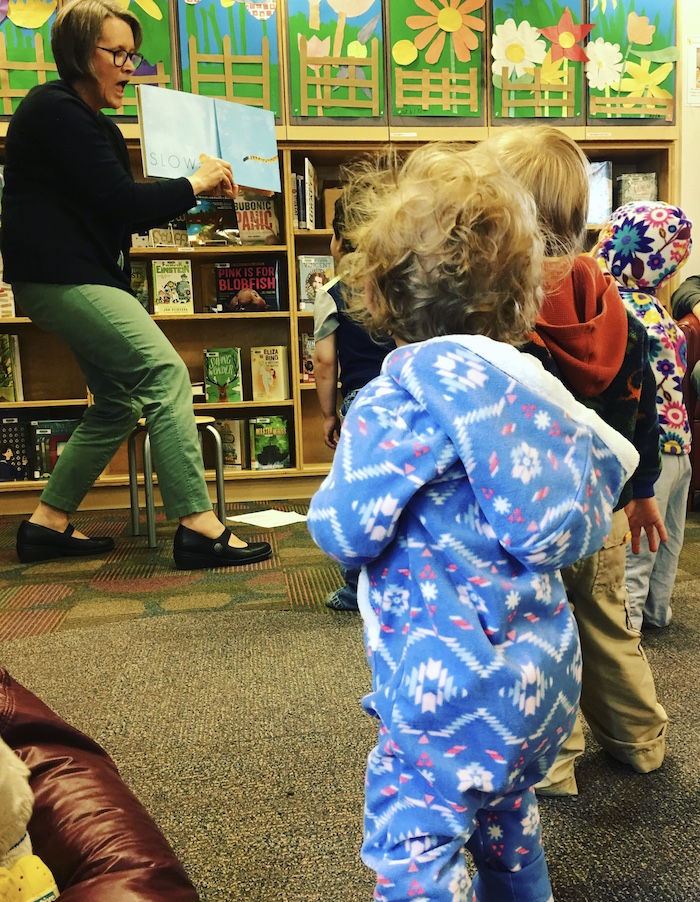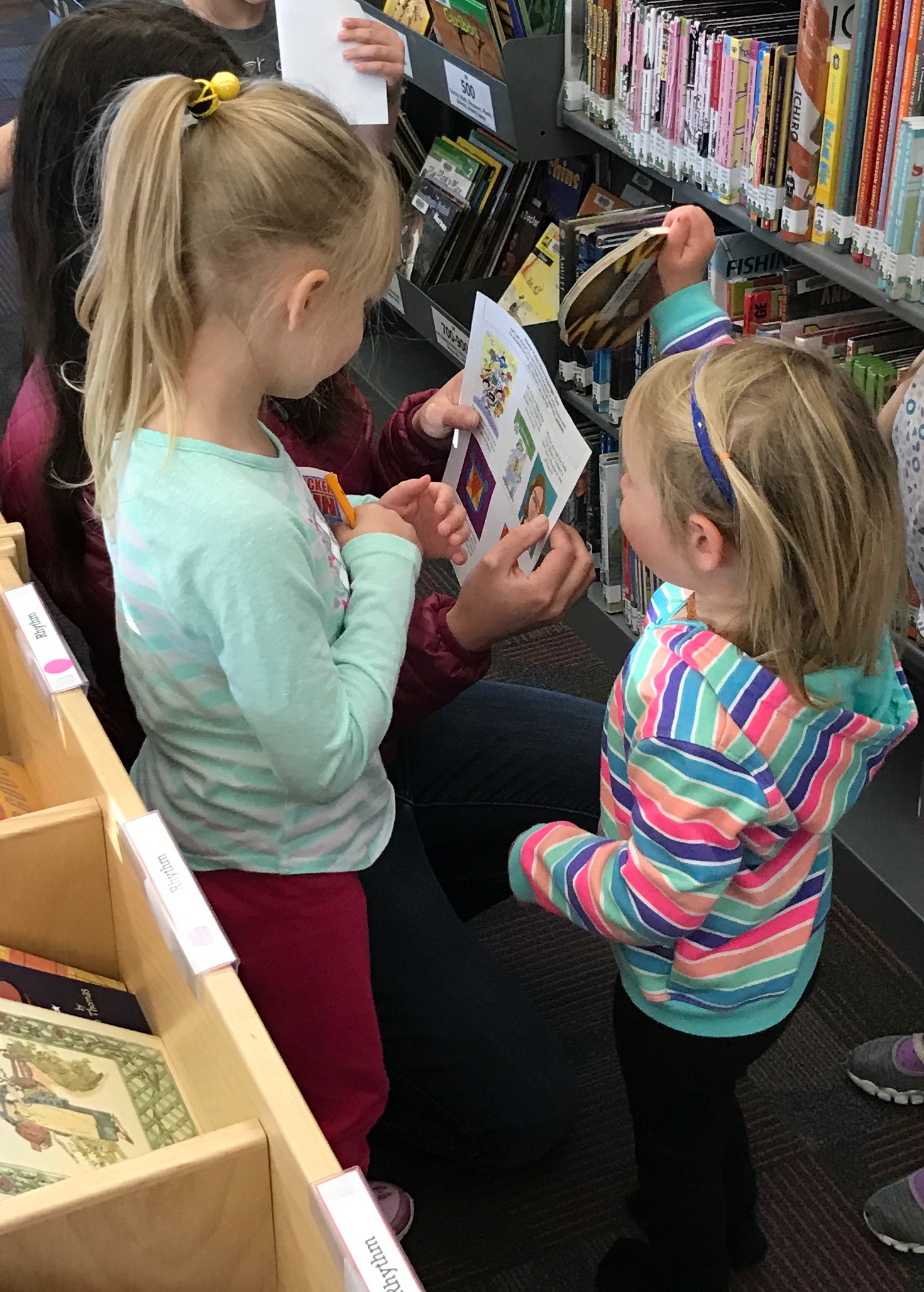This month we’re kicking off a series of posts on media mentorship, a term coined by Lisa Guernsey in 2014. We’re thrilled to have Claudia Haines and Cen Campbell, authors of the recently released Becoming a Media Mentor: A Guide for Working with Children and Families, share their expertise as librarians.
Have you been to your local public library lately?

On any given day, all across the country, something amazing happens. Herds of young children, caregivers in tow, tumble through the front doors of their local public libraries. In big cities and small villages, library storytimes are highly valued and hugely popular community programs. Storytime, like the public library itself, is iconic. Ask any adult about their relationship to their local library and many will begin with their own fond memories of storytime.
Storytime is both a powerful learning experience and the tip of the iceberg in terms of what the public library as a whole offers. In just minutes, a children’s librarian, a gaggle of young children from all walks of life, and their caregivers create a relationship built around literacy. Today, storytime has evolved into an interactive conversation. No longer are children shushed while the librarian reads a few classics. In fact, in some cases, storytime can be quite loud! For many families, storytime is a gateway into the world of early literacy. Librarians connect children with high quality and age-appropriate books, songs, and activities that feed the imagination, spark curiosity, and explore ideas.
But the relationship with families doesn’t stop when storytime is over.
Caregivers linger to look for books, puzzles, audiobooks, music, and magazines in the library’s curated collection. They socialize with other adults, sharing stories and advice in the library’s welcoming space. Children discover a favorite character, illustrator, author, or subject in book bins, at featured displays, or on the library’s computers and tablets. As they play with each other using puppets and toys the library intentionally makes available, librarians get to know their communities’ families. They’re able to recommend content that’s relevant, introduce something new, and even help families find something vaguely remembered. (“I’m looking for a picture book with a blue cover and a hat on it?”)
But did you know that beyond storytime, librarians are actively seeking out conversations about family media use, and can offer resources and expertise to families with questions about newer forms of media, too?
Librarians have long served the media needs of families, schools, and children, but it’s relatively recent that librarians have stepped up to incorporate brand new formats, engaging families in discussions about their media choices, and actively providing guidance and modeling for relationship-building media use, especially with younger children.
The launch of the iPad, and the devices that followed, have broadened librarians’ work instead of replacing it. Librarians have become media mentors, a role that is a natural fit.
Librarians are skilled evaluators and curators. We foster relationships with our community’s families, finding the resources they need in the formats they can use. We provide free programs that share new ideas, strategies, and information. Using the latest research and our professional experience, we support the varied literacy and media needs of families.
Children’s librarians serve as media mentors for kids, teens, and their families in three primary ways: media advisory, programming, and curated access. For example,
- Librarians at the Addison Public Library (IL) are recommending and teaching kids and teens how to use high-quality traditional and digital media in bilingual after-school homework programs.
- The Bozeman Public Library (MT) offers digital storytimes so families can see how digital media can support early learning and get recommendations from librarians they know.
- The Homer Public Library (AK) has a mounted iPad amongst the book stacks in the children’s section with a featured early literacy app reviewed and evaluated by the librarian.
Up until now it may not have occurred to you to go to your local library to talk to the librarian about children’s media, but we whole-heartedly invite you to do so. Whether it’s to ask a question about your own child’s media use, or to solicit recommendations for the best age-appropriate media to use in your head start center, ask a librarian!
Librarians are excellent community connectors, and they are often looking for partnership opportunities with other organizations who serve families with young children. You can read about more examples of the innovative work that librarians are doing in our book Becoming a Media Mentor: A Guide for Working with Children and Families.
What questions would you ask a librarian about apps and digital media use to support early learning? Let us know in the comments!

Claudia Haines leads storytimes, hosts Maker programs, and gets great media into the hands of kids and teens as the Youth Services Librarian and Media Mentor at the Homer Public Library (Alaska). She is a co-author of the Association for Library Service to Children’s white paper, Media Mentorship in Libraries Serving Youth (2015). She trains other librarians as media mentors and serves on both local and national committees that support families and literacy. She blogs at www.nevershushed.com. @claudiahaines
 Cen Campbell is a children’s librarian, author and the founder at LittleeLit.com. She has driven a bookmobile, managed branch
Cen Campbell is a children’s librarian, author and the founder at LittleeLit.com. She has driven a bookmobile, managed branch
libraries, developed innovative programs for babies, young children and teens, and now supports children’s librarians to serve as media mentors in their communities. She was named Library Journal Mover & Shaker in 2014 for her work on LittleeLit.com. She is
a co-author of the ALSC White Paper on Media Mentorship, Media
Mentorship in Libraries Serving Youth.




